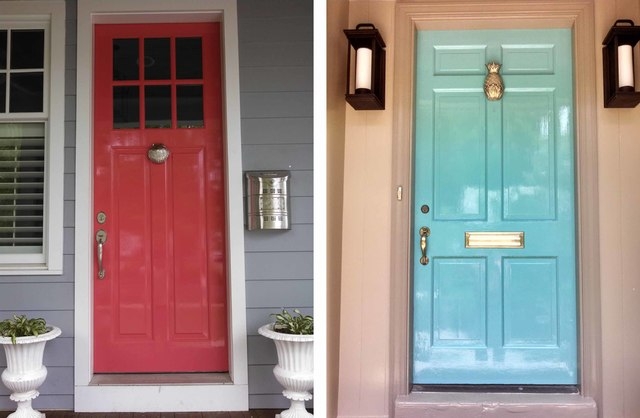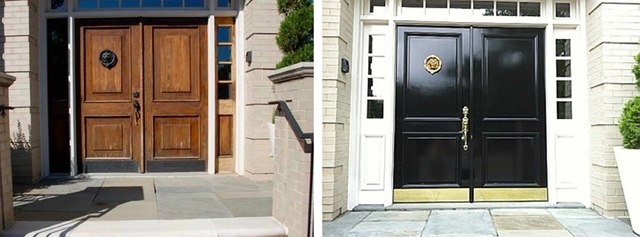Front doors reflect well on owners
The other day I dropped off a housewarming gift at a friend’s new house. After an almost yearlong renovation, she and her family were finally moving in.
Although her bathrooms were beautifully tiled, her kitchen was in full working order and her floors were newly sanded and stained, her front door looked like a toddler had painted it — it was a patchwork of splotchy blue strokes, some muddy and dull, others glossy and bright with areas of natural wood poking through. I asked what had gone wrong. She explained that she had wanted a high-gloss royal blue front door, like the ones you see in Paris or London, but despite buying the best materials possible, her painter was not skilled enough to achieve such a lofty goal.
Coincidentally, I told her, I was having a similar problem with a client’s front door. My client also wanted a colorful, shiny door, but ended up with a lackluster result.
Both my friend and my client were deflated; each hoped that her front door would stand out and be the crown jewel of her house’s facade. I understand their wishes: A front door is the first thing people see when they approach your house and, in some cases, it is the only thing they see, so one wants it to look good. Given that the door is about to close on the exterior painting season in the Northeast, I set out to uncover the secrets of the shiny portal.
My search led me straight to the streets of the Georgetown neighborhood in Washington, D.C., where colorful, glossy front doors are plentiful, many of them painted by Eric Linkins of Linkins Custom Painting. Linkins, who paints entire houses (both interior and exterior), is often contacted to repaint front doors only.
“I have one client who calls me every other year to change the color of her front door,” he says.
It’s not just the color, but also the mirrorlike finish that gives Linkins’ doors what he calls their “wow factor.” Such a lacquered sheen is not easy to achieve. It takes patience, skill and the best materials available.
Linkins uses only oil-based paints and he typically spends about five days working on a door (12-18 hours of labor, the rest is drying time between layers). The process involves first rough-sanding the door, then priming it with an oil primer.
Once dry, the door gets skim-coated with Swedish Putty, an oil-based high-performance spackle, which then gets sanded with a fine-grit paper (220 or finer) until the surface shines like a sheet of glass. The door then gets painted with several coats of paint (Linkins uses Fine Paints of Europe’s Hollandlac Brilliant Enamel), polishing between coats, but not after the final coat.
Building up the mirrorlike finish takes layers. Linkins typically applies five thin layers of paint or a minimum of three if he uses a tinted primer.
In a perfect world, Linkins says, he would remove the door from its hinges, strip it and paint it horizontally across two sawhorses and then let it dry vertically, but 99 percent of the doors he paints are already installed. Rather than remove the door, he removes only the weather stripping, which leaves a quarter-inch gap around the door, enough to close it between coats of paint.
He also creates a temporary tent around the door to keep dust and debris away. Linkins charges around $600 for his craft, not including materials.
John Learnard of Coloralchemist in Arlington, Va., takes a bit of a different approach. Learnard specializes in historic restoration and typically works on 100-plus-year-old homes.
He almost always removes the door he is working on and puts up a temporary barricade. Then, he puts the door in a strip tank to remove all old paint and he sends the hardware out to be polished.
He stresses the importance of removing everything because “a high-gloss finish has to be flawless in preparation because the finish shows everything.” Once the door is stripped, Learnard and his team follow a process similar to Linkins’, applying coat after coat of paint, always with a brush, never with a roller (Learnard says there is a major difference between paint that is rolled and paint that is hand-brushed — hand-brushed is a lot smoother).
Learnard also stresses the importance of materials. He, too, prefers Fine Paints of Europe to get the best high-gloss finish and he only uses hand-made ox ear-hair brushes from Corona. Learnard’s prices are significantly higher, approximately $3,500 to restore a historic door or $1,800 to paint a new door.
But say you can’t afford to hire Linkins or Learnard to paint your front door or you are averse to using oil-based paint. Can you still get the shiny look of a London door? Sort of.
Ben Stillwell, a Lowe’s associate, says that to get the very shiny lacquered look, you really do have to use oil-based paint, but he notes that there have been tremendous improvements in latex paint, including the addition of UV protection to prevent fading. He also stresses the ease of use and cleanup of latex paint compared to oil-based, which for the novice painter is key.
For the DIYer, Stillwell says to start with a bonding primer, which, unlike latex primers, is sandable so you can buff out any lines or inconsistencies. Apply several coats of the bonding primer, drying and sanding with a 180- or 220-grit paper between layers. Apply enough layers of primer to color the grain of the wood.
If your final paint color is dark, then Stillwell recommends tinting the bonding primer a light gray (just add black paint) because it balances light absorption so that you get better color with fewer coats of paint. Once your final coat of primer has dried, apply several coats of semigloss latex paint, drying between each. For a shiny finish, Stillwell suggests applying a couple of coats of Polycrylic in a gloss finish and lightly sanding between coats with a 220-grit paper to remove any particles of dust that may have settled on the wet surface.
Mayhew, a “Today” show style expert and former magazine editor, is the author of “Flip! for Decorating.”


















